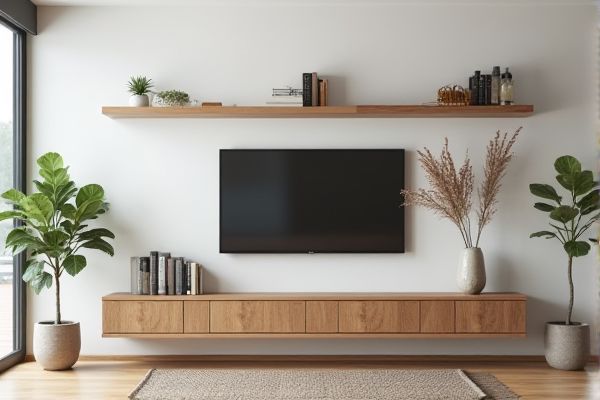
A space-saving rack maximizes storage by utilizing vertical or compact areas, while a floating shelf offers a sleek, minimalist look by appearing to "float" without visible supports. Explore the rest of the article to discover which option best suits your space and design preferences.
Table of Comparison
| Feature | Space-Saving Rack | Floating Shelf |
|---|---|---|
| Design | Vertical, multi-tiered structure maximizing floor space | Wall-mounted, minimalist shelf with no visible brackets |
| Installation | Requires floor placement; minimal assembly | Needs wall mounting with screws and anchors |
| Storage Capacity | High capacity; multiple shelves for diverse items | Medium capacity; ideal for lightweight display items |
| Space Efficiency | Optimizes vertical floor space; suitable for corners | Frees up floor space completely |
| Materials | Metal, wood, or plastic frames | Wood, MDF, or glass panels |
| Use Cases | Storage rooms, kitchens, offices | Living rooms, bedrooms, bathrooms |
| Weight Limit | Typically supports heavier items (up to 100 lbs per shelf) | Supports lighter loads (usually up to 30 lbs) |
| Visual Appeal | Functional and practical look | Sleek, modern, and clean aesthetics |
Space-Saving Rack vs Floating Shelf: A Quick Comparison
Space-saving racks maximize vertical storage by providing multiple tiers, ideal for organizing larger items or cluttered spaces efficiently. Floating shelves offer a minimalist design, attaching directly to walls without visible brackets, making them perfect for displaying decor or light objects while preserving floor space. Your choice depends on whether you prioritize bulk storage capacity or sleek, unobtrusive aesthetics for your room.
Key Features and Benefits of Space-Saving Racks
Space-saving racks maximize your storage capacity by utilizing vertical space and offering adjustable shelves that can accommodate items of various sizes. They provide sturdy support with durable materials like metal or reinforced wood, making them ideal for heavy or bulky items without compromising stability. These racks enhance organization and accessibility, reducing clutter and optimizing room layout in any living or working space.
Essential Advantages of Floating Shelves
Floating shelves offer essential advantages such as sleek, minimalistic design that maximizes floor space, making them ideal for smaller rooms or apartments. Their installation directly on walls frees up valuable floor area without bulky supports, providing a clean, modern look while maintaining strong storage capacity. You can easily customize floating shelves to fit any room layout, enhancing both aesthetic appeal and functionality.
Design Versatility: Rack vs Shelf
Space-saving racks offer greater design versatility with adjustable components and multiple tiers, allowing you to customize storage solutions for varied items and room layouts. Floating shelves provide a sleek, minimalistic look that seamlessly blends with modern decor, ideal for showcasing decorative pieces without overwhelming space. Choosing between the two depends on whether you prioritize flexible storage capacity or a clean, unobtrusive design aesthetic.
Installation Process: Which Is Easier?
Floating shelves feature a straightforward installation process, often requiring just a drill, anchors, and screws, making them suitable for quick, hassle-free mounting on walls. Space-saving racks may involve multiple components, such as assembling the frame and securing it to various surfaces, which can be more time-consuming and complex. Your choice depends on whether you prefer the simplicity of floating shelves or are willing to invest more effort for the versatile storage options offered by space-saving racks.
Space Efficiency: Maximizing Small Areas
Space-saving racks optimize small areas by offering vertical storage with multiple tiers, making them ideal for maximizing limited floor space in compact rooms. Floating shelves provide a minimalist solution by mounting directly on walls, freeing up floor area and enhancing spatial flow without bulky supports. Choosing between the two depends on your specific needs for accessibility and design, ensuring your space is efficiently utilized.
Storage Capacity: Rack and Shelf Performance
Space-saving racks offer higher storage capacity by utilizing vertical space with multiple tiers, ideal for organizing bulky or numerous items efficiently. Floating shelves provide a sleek, minimalistic look but typically accommodate lighter loads and fewer items, making them suitable for decorative displays or small essentials. Your choice depends on whether maximizing storage volume or enhancing aesthetic appeal is the priority in your space.
Aesthetic Impact in Modern Interiors
Floating shelves create a minimalist aesthetic by offering clean, uncluttered lines that enhance modern interiors with a sense of openness and lightness. Space-saving racks, while functional, often introduce bulkier elements that can disrupt sleek design schemes and reduce visual flow. Your choice between the two should consider how each complements contemporary decor, balancing practical storage needs with the desired aesthetic impact.
Durability and Maintenance Concerns
Space-saving racks often feature sturdy metal or reinforced wood construction, providing higher durability and enhanced load-bearing capacity compared to floating shelves, which commonly use lighter materials and can be prone to sagging over time. Maintenance of space-saving racks is straightforward due to their solid frames and easy-to-clean surfaces, while floating shelves require careful wall anchoring to prevent damage and might need periodic tightening or reinforcement. Choosing between these options depends on balancing long-term durability needs with aesthetic preferences and ease of upkeep.
Choosing the Right Option for Your Space
Space-saving racks provide versatile storage with multiple tiers, ideal for organizing larger items and maximizing vertical space in small rooms. Floating shelves offer a minimalist look by mounting directly to walls, perfect for displaying decorative objects without occupying floor space. Selecting the right option depends on your storage needs, available wall space, and desired aesthetic, balancing functionality with interior design.
 homyna.com
homyna.com